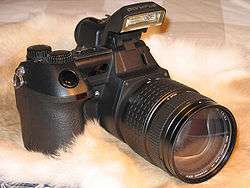Olympus E-10
 | |
| Overview | |
|---|---|
| Type | Zoom-lens reflex camera |
| Lens | |
| Lens | Fixed 35–140mm, f/2–2.4 |
| Sensor/Medium | |
| Sensor | 2/3-inch CCD |
| Maximum resolution | 2,240 × 1,680 (4 million) |
| ASA/ISO range | 80, 160, 320 |
| Storage | CompactFlash(CF) (Type I) or SmartMedia(SM) |
| Focusing | |
| Focus modes | Manual, Auto |
| Focus areas | single area |
| Exposure/Metering | |
| Exposure modes | Program Auto, Aperture Priority, Shutter Priority, Manual |
| Exposure metering | TTL full-aperture exposure metering |
| Metering modes | ESP digital, Center-Weighted, Spot |
| Shutter | |
| Shutter | Beam splitting prism |
| Shutter speed range | 1/640 to 2 seconds, bulb |
| Continuous shooting | 3 frame/s up to 4 shots |
| Viewfinder | |
| Viewfinder | Optical TTL through beam splitting prism |
| General | |
| Rear LCD monitor | 1.8-inch 'flip-up' |
| Weight | 1050 g |
The Olympus E-10 is a digital single-lens reflex camera with a 4.0-megapixel CCD image sensor that was introduced in 2000. Unlike most digital SLRs the camera is not a system camera – its lens is fixed to the body. It has a TTL optical viewfinder, and a 4× optical zoom lens with lens aperture f/2–2.4. Instead of a moving (reflex) mirror a beam splitting fixed (non-reflex) prism is used to split the image between the optical viewfinder and CCD.[1] Thus it was possible to have a live view on the LCD and in parallel see the image in the TTL viewfinder.
The E-10 has a strong metallic case that weighs in at approximately 37 oz. (1050 g). It was succeeded by the 5-megapixel Olympus E-20, announced in 2001.
References
- ↑ "Specifications", Olympus E-10 review, Digital Photography Review
External links
![]() Media related to Olympus E-10 at Wikimedia Commons
Media related to Olympus E-10 at Wikimedia Commons